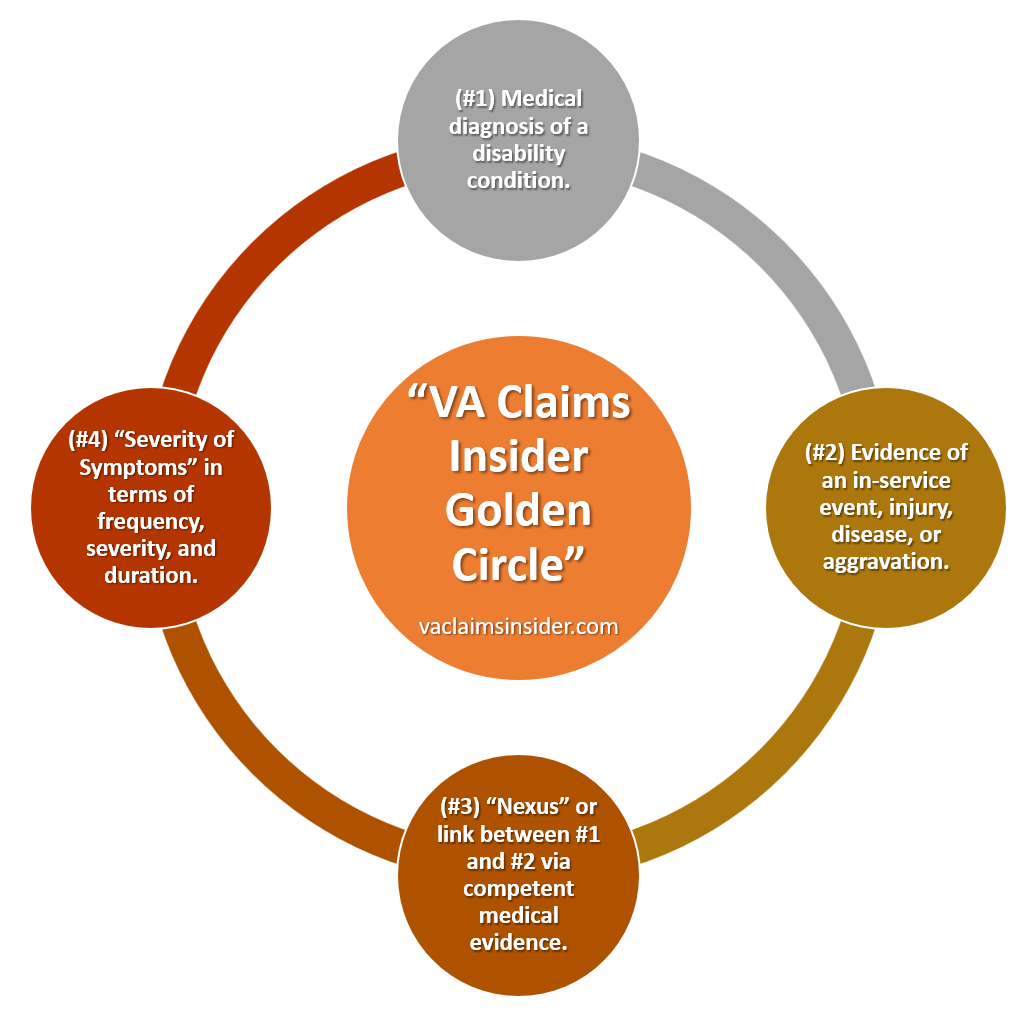Looking for Expert-Level VA Claim Answers?📱Call Us Now! 737-295-2226
In this Insider’s Guide, VA disability expert Brian Reese reveals and explains 8 ways to increase your VA disability rating.
The key to getting an increased VA disability rating is to file a new claim with new and relevant medical evidence.
In general, you need to provide the VA with medical evidence that shows how your disability symptoms have worsened in terms of frequency (how often), severity (how bad), and duration (how long).
Remember this: MEDICAL EVIDENCE WINS VA CLAIMS!
Table of Contents
Summary of Key Points
- Veterans have 8 options to increase an existing VA rating: File a New VA Disability Increase Claim, File a New Claim for Direct Service Connection, File a New Claim for Secondary Service Connection, File a New Claim for Presumptive Service Connection, File a New Claim for Service Connection via Aggravation, File a New Appeal for a Previously Denied VA Disability Claim, File a New Claim for Total Disability Individual Unemployability (TDIU), or File a New Claim for Special Monthly Compensation (SMC).
- Filing a new claim for increased compensation on conditions already service-connected at 0% or higher is the simplest and easiest route to raising your existing VA disability rating.
- Disability Benefits Questionnaires (DBQs) are great for simple increase claims and might result in a VA rating increase without having to attend a C&P exam.
- If your condition was not diagnosed during active duty military service (no evidence in your service treatment records) or you’ve been out of the military for more than 12 months, a Nexus Letter from a private healthcare provider is highly recommended.
- If you’re trying to increase your combined VA disability rating, consider filing high value VA claims rated at 30% or higher.
4 Essential Elements to Increasing Your VA Disability Rating

There are four mission critical elements you must prove to get your VA disability rating increased or to get your conditions service connected for the first time.
It’s called The VA Claims Insider Golden Circle: (#1) Medical diagnosis of a disability condition, and (#2) Evidence of an in-service event, injury, disease, or aggravation, and (#3) Nexus (link or connection) between #1 and #2 via competent medical evidence, such as a Nexus Letter, and (#4) “Severity of Symptoms” in terms of frequency (how often), severity (how bad), and duration (how long).
Option #1: File a New VA Disability Increase Claim
The easiest way to increase your VA disability rating is to file a new increase claim online for conditions already service connected at 0% or higher; here’s a 17-step tutorial where we show you how.
For example, let’s say you’ve got a 50% VA rating for PTSD, but you think the preponderance of your symptoms meet the 70% rating criteria.
You simply open a new claim on VA.gov and click the radio button that says, “I’m filing a claim for a new condition or for a condition that’s gotten worse.”
Make sure you upload new medical evidence in the form of medical records, Disability Benefits Questionnaires (DBQs), and/or Nexus Letters to show how your symptoms have become worse over time.
Pro Tip: DBQs from private healthcare providers are great for simple increase claims. Why? Since you’re already service connected but are applying for an increase in severity of symptoms, a DBQ with your claim submission means your claim is “decision ready.” This means the VA rater can potentially review and rate the claim without ordering a separate C&P exam.
Option #2: File a New Claim for Direct Service Connection
Regardless of your current VA disability rating, you can always file a new claim for direct service connection and add new conditions.
For example, let’s say you’re rated at 70% combined for mental health and tinnitus, but you want to file a new claim for headaches and GERD.
Open a new claim on VA.gov and click the radio button that says, “I’m filing a claim for a new condition or for a condition that’s gotten worse.”
Make sure you upload new medical evidence in the form of medical records, especially your service treatment records along with DBQs or Nexus Letters.
Pro Tip: If your condition was not diagnosed during service or if there are no documented symptoms in your military medical records or you’ve been out of the military for more than 12 months, you should strongly consider getting a Nexus Letter to help you prove service connection. Why? Because you don’t have medical evidence that the disability existed during service.
Option #3: File a New Claim for Secondary Service Connection
If you have a new secondary condition that you think was proximately due to or aggravated by another service-connected disability rated at 0% or higher, you should open a new claim, add the new disability condition, and select the option for secondary service connection.
For example, maybe you have sleep apnea diagnosed and you want to file it as a new secondary claim for secondary service connection.
You can file a claim for new claim for sleep apnea secondary to another disability that’s already service connected.
Pro Tip: If you’re filing a new claim for secondary service connection, a Nexus Letter is highly recommended. Why? Because a secondary claim requires “Medical Nexus Evidence” that your new disability is proximately due to or aggravated by a service-connected disability.
Option #4: File a New Claim for Presumptive Service Connection
Presumptive service connection is an easy way to increase your VA disability rating, assuming you meet the eligibility criteria.
A presumptive disability is a condition that the VA presumes to be service connected, even if there’s no specific “Nexus” for service connection.
Here’s how it works: If you served at X location during the qualifying period and developed Y condition as a result, then X + Y = automatic service connection.
VA presumptive conditions are easy to win and can help you increase your VA disability rating because you just need to show on your DD 214 that you were in an eligible location during a specific period and that you developed a qualifying disability as a result.
Pro Tip: There are 10 categories and more than 200 conditions eligible for presumptive disability. Also, you do not need a Nexus Letter for presumptive conditions. Why? Because presumptive conditions do not have a specific “Nexus” requirement under the law.
Option #5: File a New Claim for Service Connection via Aggravation
Another way to increase your VA disability rating is to file a new claim for service connection via aggravation.
This type of service connection includes two types: (#1) aggravation of a pre-service disability and (#2) secondary service connection via aggravation.
For example, let’s say you entered military service with flat feet, but the wear and tear of active service aggravated your flat feet beyond its natural progression, leading to foot and heel pain.
In this example, you’re eligible to file a new claim for aggravation of pre-service disability.
Secondary service connection via aggravation means a current service connected disability “aggravated” a non-service connected disability.
For example, maybe you have obstructive sleep apnea (OSA) that was aggravated by obesity/weight gain due to side effects of SSRI medications taken to manage your symptoms of service-connected PTSD.
You can file a claim for sleep apnea secondary to PTSD with obesity/weight gain as an intermediate step for service connection.
Pro Tip: A Nexus Letter is highly recommended for service connection via aggravation, including aggravation of a pre-service disability and secondary service connection via aggravation.
Option #6: File a New Appeal for a Previously Denied VA Disability Claim
If you’ve had a previous disability claim denied, you’ll need to appeal it using one of three options:
Higher Level Review (HLR)
This appeal option involves having a more senior VA official review the same evidence that was originally submitted. No new evidence can be submitted in this review. The senior reviewer looks for errors in the initial decision or provides a new interpretation of the evidence.
This is a good option if you believe that there was an error in the initial decision or that the evidence you originally provided was not properly considered.
Supplemental Claim
Under this option, veterans can submit new and relevant evidence that was not included in their original claim. The VA will then reevaluate the claim considering this new evidence.
This is suitable if you have additional evidence that supports your claim or if you can obtain new evidence that strengthens your case.
Board of Veterans’ Appeals (BVA)
Also known as a Board appeal, this option allows you to have your appeal reviewed by a Veterans Law Judge at the Board of Veterans’ Appeals in Washington, D.C. You can choose one of three dockets:
- Direct Review Docket: A review by the Board based on the evidence already in your VA file. No new evidence can be submitted, and no hearing will be held.
- Evidence Submission Docket: You can submit additional evidence but must do so within 90 days of your Notice of Disagreement. No hearing will be held.
- Hearing Docket: You can request a hearing with a Veterans Law Judge, during which you can present new evidence and make arguments. You can submit additional evidence within 90 days after the hearing.
Pro Tip: Supplemental Claims are the fastest appeal option right now at ~5-6 months from beginning to end. Higher Level Reviews are the second fastest appeal option at ~6-8 months. Board Appeals are the slowest appeal option with a Direct Review taking around 1 year, Evidence Submission around 1.5 years, and Hearings at 2 years minimum.
Option #7: File a New Claim for Total Disability Individual Unemployability (TDIU)
If you can’t work because of your service-connected disabilities, you might qualify for an extra-scheduler VA rating called Individual Unemployability or TDIU.
Eligible veterans can get paid at the highest possible rating by law (the 100% VA pay rate), even if their combined VA rating is less than 100%.
You can file a claim for TDIU online at VA.gov after you’ve added new disabilities and click through to later screens.
To file a claim for Individual Unemployability, you’ll also need to fill out and upload the following:
- A Veteran’s Application for Increased Compensation Based on Unemployability (VA Form 21-8940) Download VA Form 21-8940, AND
- A Request for Employment Information in Connection with Claim for Disability Benefits (VA Form 21-4192) Download VA Form 21-4192.
Pro Tip: VA unemployability means you’re unable to maintain “substantially gainful employment” due to your service connected disabilities. The income limits for TDIU benefits are based on the U.S. Census Bureau’s poverty thresholds, and these limits are subject to change annually with cost of living adjustments. As of the most recent data, the estimated income limits for 2024, accounting for projected cost of living adjustments, are approximately: Veterans under 65 years old: $17,115. Veterans 65 years and older: $15,778.
Option #8: File a New Claim for Special Monthly Compensation (SMC)
The final option to get increased VA disability benefits is to file a new claim for Special Monthly Compensation (SMC).
SMC is an extra benefit provided by the VA to veterans or their eligible dependents who have specific disabilities or combinations of disabilities.
VA SMC benefits are designed to compensate veterans for disabilities that result in a higher level of impairment or a need for extra assistance or care.
Some common examples of situations that may qualify a veteran for SMC include: Loss of use of a creative organ, loss or loss of use of one or more limbs, need for aid and attendance due to disabilities, blindness or visual impairment, severe deafness or hearing impairment, housebound status due to disability, need for assistance with activities of daily living, or a combination of disabilities that result in a high level of impairment.
Pro Tip: Extra scheduler SMC pay rates can go much higher than the scheduler pay rates. For example, the max VA disability benefit is for Special Monthly Compensation (SMC) R.2/T, which has a minimum monthly payment of $10,697.23 and can exceed $11,000 per month with dependents.
Increase Your VA Rating Fast: Get $18,800+ Worth of High-Value VA Claim Resources FREE!
Fellow Veterans, I’m about to make you the craziest offer I’ve ever made…
Why would I do this?
A few reasons:
- GOD – I believe God put me here on earth to serve Veterans. You are my purpose for existing.
- FINANCIAL FREEDOM – I want to help you change your life by getting more tax-free compensation and benefits you’ve earned from the VA.
- JUSTICE & VALIDATION – I want you to get the justice and validation you deserve for serving our country.
Okay Brian, what is this crazy offer?
➡️ First, I’m going to let you join our #1 rated VA Claims Insider Elite program today where you’ll learn how to increase your VA rating faster (with no fee up-front – if we don’t win, you don’t pay). Click HERE to view our published Pricing Guide.
➡️ Second, I’m going to gift you $18,800+ worth of high-value VA claim resources for FREE right now just for signing up today.
GET THE VA CLAIMS INSIDER “GOT YOUR SIX” BONUS OFFER
Here’s a sliver of what you get right now:
- #1. Instant access to the VA Claims Insider Elite program proprietary portal and resources. You also get a Coach assigned to you in 15-minutes or less from signing up today! On our platform, you can attend 44 Live VA Claims Educational Classes Taught Per Month, 19 Written Step-by-Step Tutorials, 18 Video Explainers, 7 Templates & Examples, 5 eBooks & Infographics, and 1 Worksheet ($5,000 VALUE)
- #2. Instant access to the *LIVE* 24/7/365 VA Claims Insider Mastermind group so you can ask questions and get personalized help from me, my team, and fellow disabled veterans in the program ($564 VALUE)
- #3. The Insider’s Guide to the #1 Disability EVERY Veteran should file for (Tinnitus), if eligible, fully documented the way it should be ($1,000 VALUE)
- #4. Learn more about direct award academic scholarship programs for your spouse and dependents, in a simplified, and easy to understand way ($5,000 VALUE)
- #5. How to get a 100% P&T VA disability rating (if you qualify), TONS of additional benefits (like no property taxes), and over $4,000/month, tax-free compensation, for life ($4,000 VALUE)
TOTAL VALUE SO FAR TODAY = $15,564
Plus, I’m Gifting You These 3 FREE Bonuses Today:
- [BONUS #1] The “SEM Method Blueprint” with video explainer so you know HOW to WIN your VA Claim FASTER, regardless of past denials or the VA claims backlog ($1,997 VALUE)
- [BONUS #2] FREE one-year membership to Military Disability Made Easy “All Access” program, which is 38 CFR Part 4 on steroids with detailed explanations plus pictures (coupon code provided after joining VA Claims Insider Elite! ($239 VALUE)
- [BONUS #3] Members-Only Discounted Pricing to Preferred Provider Network Services for Mental Health Evaluations & IMOs, DBQs, and Nexus Letters ($1,000 VALUE)
TOTAL VALUE RIGHT NOW WITH FREE BONUSES = $18,800
To get this crazy offer, click HERE right now and complete the 3-step intake process or click the button:
Note: A VA Claim Expert Coach will reach out to you in 15-minutes or less to get you started on your VA claim success journey!
***Hurry because this offer can close at any time depending on demand***
I can’t wait to meet you, serve you, and help you change your life.
Talk Soon,
Brian Reese, Air Force Disabled Veteran (2003-2012), Founder @ VA Claims Insider
P.S. If you join today, you’ll get a FREE copy of my brand-new eBook VA Claim Secrets: Expert Tips and Proven Strategies to Win Your VA Disability Claim Faster. ***This is a limited time offer!***
Want to Increase Your VA Rating? WE GOT YOUR SIX!
- VA Claims Insider is a highly-rated, veteran-owned and operated business.
- 25,000+ disabled veterans served in our membership programs since 2016.
- 30% average VA rating increase for veterans who complete our #1 rated Elite program.
- Employs 200+ teammates; comprised of 44 veterans as well as military spouses.
- 4.7/5.0 average rating out of 5,000+ total reviews; over 4,000 5-star reviews.
About the Author

Brian Reese
Brian Reese is a world-renowned VA disability benefits expert and the #1 bestselling author of VA Claim Secrets and You Deserve It. Motivated by his own frustration with the VA claim process, Brian founded VA Claims Insider to help disabled veterans secure their VA disability compensation faster, regardless of their past struggles with the VA. Since 2013, he has positively impacted the lives of over 10 million military, veterans, and their families.
A former active-duty Air Force officer, Brian has extensive experience leading diverse teams in challenging international environments, including a combat tour in Afghanistan in 2011 supporting Operation ENDURING FREEDOM.
Brian is a Distinguished Graduate of Management from the United States Air Force Academy and earned his MBA from Oklahoma State University’s Spears School of Business, where he was a National Honor Scholar, ranking in the top 1% of his class.




